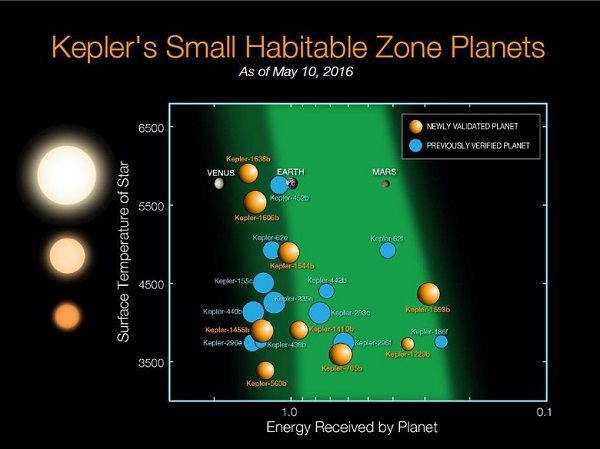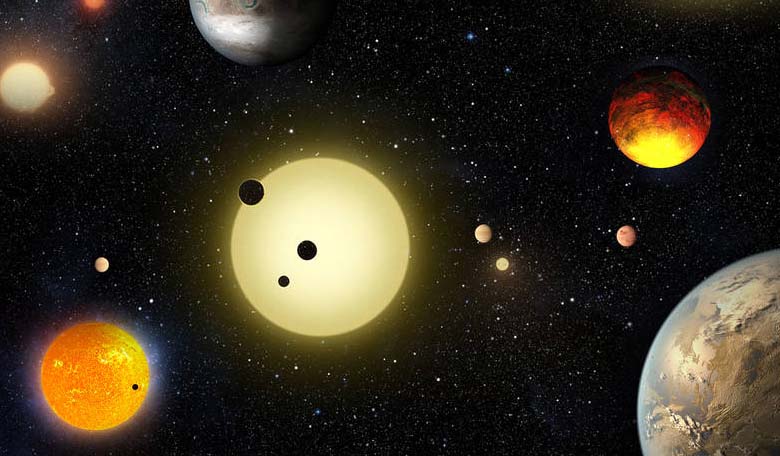cientists working on the Kepler mission announced yesterday the single largest finding of planets to date by using a new technique to spot real planets from potential imposter signals. During a teleconference with mission scientists, Timothy Morton, associate research scholar at Princeton University in New Jersey and lead author of the scientific paper published in The Astrophysical Journal, said “today, we are announcing the discovery of 1284 new planets in the Kepler mission. This is the most exoplanets that have ever been announced at one time. This more than doubles the number of known exoplanets.”
Launched in 2009, Kepler has spent more than four years continually watching 150,000 stars, 24hrs a day, 7 days a week, 365 days a year looking for the tell-tale sign of a would be exoplanet. The technique Kepler uses is known as the transit method and it works by measuring the dip in star light as a planet passes in front of its parent star. Kepler is sensitive enough to measure this slight dimming of starlight and therefore detect the presence of the transiting planet.
So far, using this method, Kepler scientists have identified about 4700 exoplanet ‘candidates’ and have validated about 1000 of them as actual exoplanets. Candidate planets at the time of labelling, are just that – candidates – and in order to weed out imposter signals from the real thing, planet candidates have traditionally been assessed for their authenticity on a case by case situation, that includes detailed follow up observations by ground telescopes.
However, these detailed follow up observations are very time and resource consuming. To overcome this, scientists have developed a new method to quantify the probability that any given exoplanet signal is in fact caused by a planet, without requiring any follow-up observations. This involves simulating the detailed shapes of the signals caused by both planets and imposters and then simulating how common they expect imposter signals to be in the Galaxy. Combining these two types of information gives scientists a reliability score between zero and one and candidates with a reliability greater than 99 percent are classed as validated planets.
It is also possible however, that those with reliability of less than 99 percent are still more likely to be planets than imposter signals, known officially as astrophysical false positives, even though at this stage they cannot be claimed as true exoplanet discoveries.
In this latest announcement, Kepler scientists have doubled the number of known exoplanets smaller than the size of Neptune in our own Solar System and found over a hundred that are smaller than 1.2 times the size of Earth. Given their size, the team speculate that these planets are almost certainly rocky in nature. Considering that Kepler candidates are generally much smaller planets orbiting around faint stars than those that are found by ground-based telescopes, it is no easy task to spot the genuine article.
 Since Kepler launched in 2009, 21 planets less than twice the size of Earth have been discovered in the habitable zones of their stars. The orange spheres represent the nine newly validated planets announcement on May 10, 2016. The blue disks represent the 12 previous known planets. These planets are plotted relative to the temperature of their star and with respect to the amount of energy received from their star in their orbit in Earth units. The sizes of the exoplanets indicate the sizes relative to one another. The images of Earth, Venus and Mars are placed on this diagram for reference. The light and dark green shaded regions indicate the conservative and optimistic habitable zone. Credits: NASA Ames/N. Batalha and W. Stenzel
Since Kepler launched in 2009, 21 planets less than twice the size of Earth have been discovered in the habitable zones of their stars. The orange spheres represent the nine newly validated planets announcement on May 10, 2016. The blue disks represent the 12 previous known planets. These planets are plotted relative to the temperature of their star and with respect to the amount of energy received from their star in their orbit in Earth units. The sizes of the exoplanets indicate the sizes relative to one another. The images of Earth, Venus and Mars are placed on this diagram for reference. The light and dark green shaded regions indicate the conservative and optimistic habitable zone. Credits: NASA Ames/N. Batalha and W. Stenzel
Despite announcing the single largest finding of planets to date, it has not all been plain sailing. Talking at the teleconference yesterday, Natalie Batalha, co-author of the paper and the Kepler mission scientist at NASA's Ames Research Center in Moffett Field, California said, “before there was a Kepler spacecraft there were teams building ground-based precursors to demonstrate that transit photometry is a viable method for detecting planets. In those early days we were really plagued by false alarms – signals that looked like transiting planets but were later deemed imposters. We could count on throwing away at least 60 - 70 percent of the transit-like signals that the telescope recorded.”
The outlook for exoplanet surveys improved dramatically with the launch of Kepler and within its first few months of data gathering, hundreds of transit signals were identified. “But we were cautious and were prepared to have to throw away 60 - 70 percent of the candidates like we did with the ground based surveys,” explained Batalha. “Tim was the first person to critically examine that assumption. He asked the question, how many confounding sources should we expect to see given what we know about the galaxy and given the quality of the Kepler data. Tim told us to expect that about 90 percent of Kepler’s candidates are likely to be real planets. Indeed if you go through the data, only around 16 percent have a larger than 50-50 likelihood of being an imposter,” continued Batalha.
With such a rich data set to trawl through it has been imperative to find a quicker solution and narrow down the search for true exoplanet signals. Batalha explains that Kepler achieves this by using statistics to sample the Galaxy to help understand how many planets there are and how far out we have to search in order to find habitable planets like Earth. Kepler is still actively observing under the guise of the K2 mission and is expected to continue until its fuel sources run out in the next two years.











